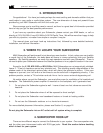
page 11powered subwoofers
Now listen to the same musical passage as you did earlier, concentrating on the mid-bass region.
If you hear less bass, the original connections were correct. If you hear more bass, the new
connections are correct.
If you have two Subwoofers, perform one test for each Subwoofer. When you perform each test,
make sure the other Subwoofer is not operating by either unplugging its input cable or its power cord.
Another methods of setting correct phase requires the use of a pink noise source and a spectrum
analyzer. If you have access to these, instead of listening, place the microphone at the main listening
position and look at its display in the "mid-bass" region of 70 - 125 Hz. The wiring or switch position
that shows the greatest output in that region is the correct phase.
You need to perform this test because when Satellite speakers are located separate from a
Subwoofer, each speaker is at a different distance from your ear. In some cases, the difference will
be just enough so that the output from the Subwoofer arrives out of phase with the output of the
Satellites. When this happens, that critical mid-bass is actually cancelled. You should re-do this test
any time you move your speakers.
If you want to experiment further, you can move the Satellite speakers either towards or away from
your listening position, making changes in small increments. This will "focus" the system's sound to
its optimum. When you hear the best balance between stereo image localization and maximum impact
and output in the mid-bass, you have the ideal location.
6. USE OF THE "FILTER" CONTROL
The back panel control labelled "FILTER" sets the upper rolloff point of the Subwoofer, eliminating
mid-bass and midrange signals that are being reproduced by your Satellite speakers. The control is
a means of "fine-tuning" the transition between your Subwoofer and Satellite speakers, and it provides
a rolloff of 18 dB/octave up to 125 Hz, where the filter shifts to 36 dB/octave. In most systems, including
M&K Satellites, 85 Hz gives the best blend. If you don't want to experiment, set the control at 85 Hz.
The goal is to get a balanced
acoustic
output in your room. This is not necessarily the same as
flat electrical output. Rooms typically reinforce bass frequencies around 100 Hz, so by leaving an
electrical gap, you may actually get a smooth acoustical response where it matters, in the room.
Think of this control as a "mid-bass" fine tuning adjustment that you set to achieve the best
transition between the Satellite speakers and the Subwoofer. When you hear a smooth sound overall,
well balanced between the deep bass and the rest of the audible spectrum, the control is set properly.
7. USING TWO SUBWOOFERS
Using two Subwoofers in your audio/video system gives you the ultimate in bass performance.
You'll hear improved impact and definition, as well as greater output and dynamic range. If the
Subwoofers are located in different parts of the room, you will get a much smoother bass response,
as the room modes excited by one woofer are effectively reduced by the presence of the other.
Wiring with two Subwoofers is very simple. Instead of running two sets of speaker wires or two
interconnect cables to one Subwoofer, run one speaker wire or interconnect to each Subwoofer. You
can do this because both the left and right channel input signals are combined in the Subwoofer's input
stage. The only thing this changes is amplifier gain, and, if you want, you can compensate by setting


















